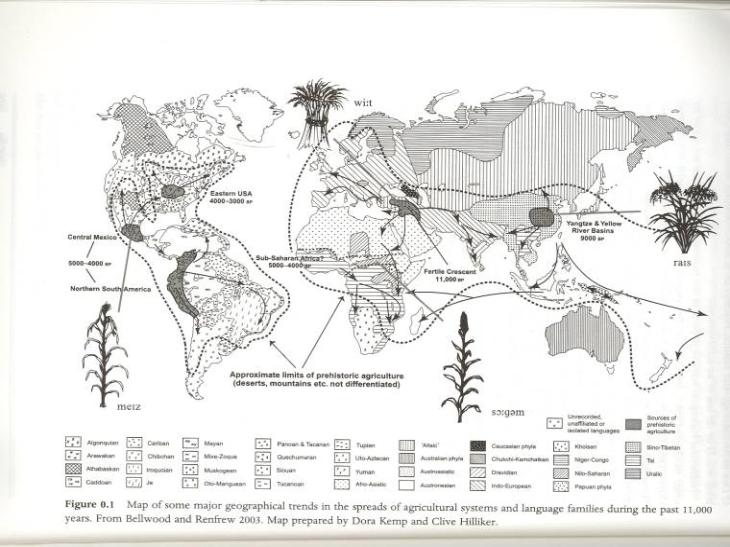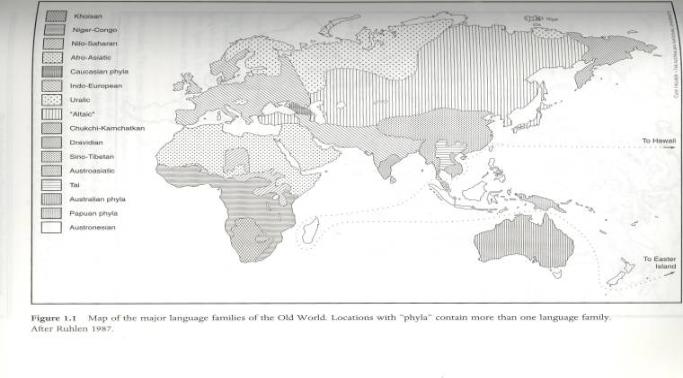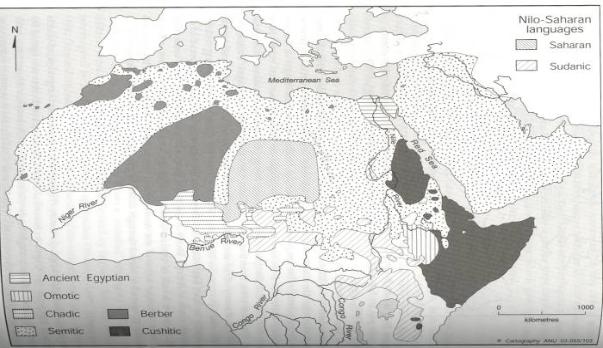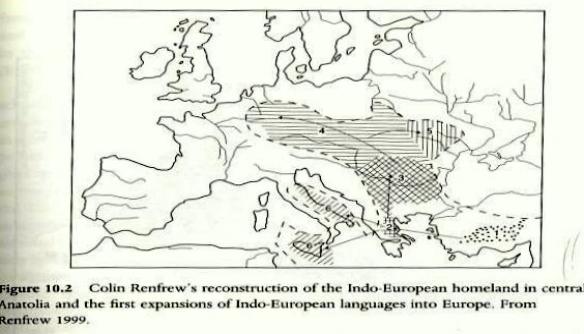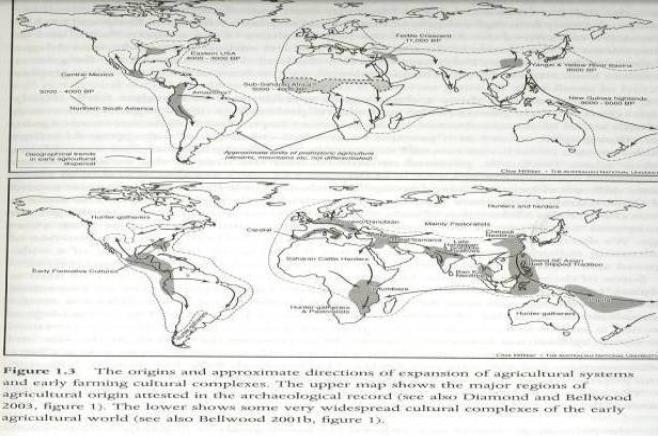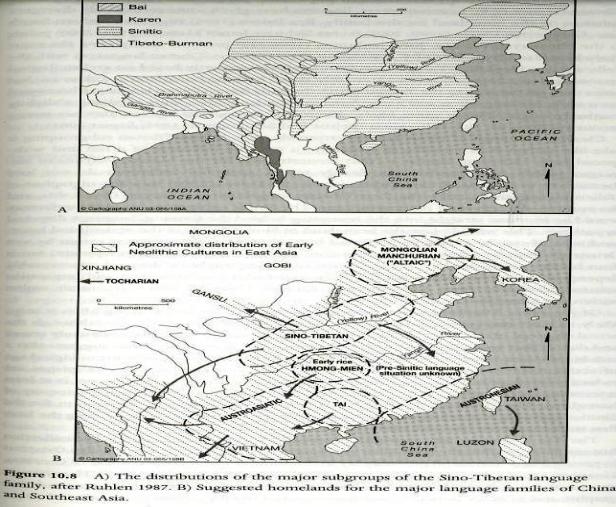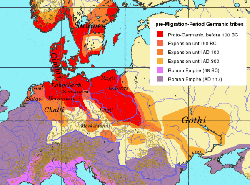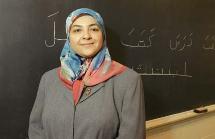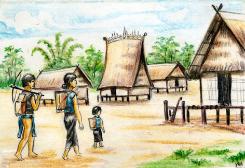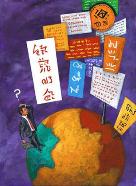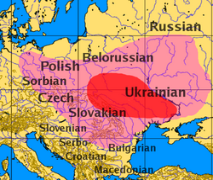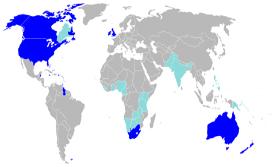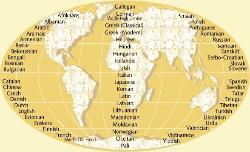' Abstract
Published research on ‘national cultures’ and their ‘cultural attitudes’ has been sparse in recent
decades. Taking a more linguistic-focused look at culture, however, may provide promising new
areas of study. The proposed research will examine how different ‘national cultures’ correlate with
‘cultural attitudes’ in national samples of college students from different gendered grammar
heritages. National cultures will be operationalized in terms of national languages and their rules
of grammar in relation to gender. Cultural attitudes will be operationalized in terms of
authoritarian, ethnic, and nationalist/patriotic responses to a uniform questionnaire (see
Appendix). Participants from 3 national cultures with different structures of grammatical gender
(German, Spanish, and English) will complete the survey, in order to gauge differences in each
group’s responses to the questionnaire’s authoritarian, ethnic, and nationalist/patriotic
constructs. Results might lead to clearer inferences about how the grammatical rules of a
language and society correlate with the values and beliefs of its citizens, in terms of authoritarian
attitudes, ethnicist (ethnocentric) attitudes, and overall national identity salience among its
citizens. First, however, four classifications and cultural heritages of gendered grammar must be
introduced.
Introduction
"’Languages differ essentially in what they must convey and not in what they may convey’"
- Roman Jakobson, 1959 (Vigliocco, et. al, 2005, p. 501)
‘”Some people argue that language just changes what you attend to… But what you attend to
changes what you encode and remember”’
- Lera Boroditsky, 2002 (Motluk, 2002, p. 35)
Before there was broadcast media, books, or even writing there have been systems of grammar.
As a determinant of culture, languages have been around much longer than contemporary
notions of religion or race, and systems of grammar constitute the first rules and structures by
which speakers must comply with in order to be understood.
It is not within the scope of this paper to outline the vicissitudes of the Sapir-Whorf hypotheses
(that language profoundly structures the perceptions of its speakers). It should be noted,
however, that a recent carefully conducted experiment found that the right brain does indeed
tend to perceive the visual world through the lens of its primary language; whereas the (more
creative; nonverbal) left brain does not (Gilbert, et. al, 2006, p. 489). This study would seem to
support cognitive psychologist Lera Boroditsky’s earlier findings (2001) that one’s native
language can affect even such basic mental concepts as time (Americans think of it horizontally;
whereas Chinese think of it vertically). As she explains, “acquiring abstract concepts requires
experience with language and… the eventual form of these concepts is largely shaped by the
language experience” (2001, p. 20). So in essence, it would appear that each ‘side’ (of the Sapri-
Whorf debate) has been at least half-right; and that the ‘do languages effect culture?’ debate
should now move forward to questions of how languages affect culture.
Cultures- particularly large, national cultures- do not comport themselves easily to the scientific
method. Languages, however, have already been categorized into families, based largely upon
their grammatical similarity. The major subfields of grammar upon which languages are classified
are: morphology, syntax, phonetics, phonology, orthography, semantics, and pragmatics. As
each individual within a family is unique, so too each language in a family also has at least some
minor grammatical elements that distinguish it from its classmates. Do certain grammatical
differences between languages correlate with certain cultural aspects of a nation that primarily
speaks this language? According to Sapir-Whorf, Boroditsky, and Gilbert, et. al, the answer
should be yes. The primary obstacle to finding such correlations has been operationalizing the
‘national cultures’ side of the equation. Before addressing this more difficult question, however,
let us first take a closer look at our grammatical variable: gender.
Gendered Grammar
“These automatic, involuntary patterns of language are not the same for all men but are specific
for each language and constitute the formalized side of the language, or its ‘grammar’”
- Benjamin Whorf, 1956 (p. 221).
Gender is part of both the semantics and pragmatics subfields of grammar- and can sometimes
be a confusing term. Although gender is most often today used as a synonym for one’s sex (i.e.
male or female), its original and scholarly definition simply constitutes a class or category- any
old classification or category of grammar- and most often refers to the noun class of word. Noun
classes, in turn, are often sex-based (as typical in Indo-European languages). In other language
families, however, noun classes have typically been based on animacy instead. In the Bantu
languages of Africa, for example, noun classes can be based on more than a dozen different
constructs.
In summary, gendered grammar may refer to either: 1) a noun or pronoun classification system in
which words are classified by either natural gender (biological; assigned to males-females only)
or arbitrary gender (assigned masculinity or femininity to objects/inanimates); or 2) any system of
noun classes- such as the extensive noun classes of Bantu languages in Africa (most of which
are not related to an object's presumed or assigned sex).
For the purposes of this study, ‘gendered grammar’ means sex-based noun classes (which are
more rationally assigned in some languages; more arbitrarily assigned in others). Non-sex-based
noun classes, such as are typical of Bantiod languages, are not included in the classification
scheme. ‘Pronominal gender’ means merely sex-based pronouns (assigned naturally/biologically;
not arbitrarily).
Greville Corbett (1991; 2005) has classified most of the world’s larger/national languages into
three categories in reference to gender. First of all, most people in the world today do not speak
a gendered language (either noun or pronominal) as their native tongue. Biological (or ‘natural’,
in linguistic parlance) gendered grammar is almost entirely an Afro-Asiatic and Indo-European
families heritage, of which there are conventionally two subcategories. Afro-Asiatic (and the
Romance subfamily, within IE) languages typically have a biologically gendered grammar system
that must be applied to all nouns. Most Germanic and Slavic languages, however, also have a
third ‘gender’ category- the neuter- which means that maleness or femaleness is only applied to
most inanimate objects; not to all inanimate objects, as with a strictly dualist system of gendered
grammar.
In addition to these three categories (1. non-gendered grammar, 2. dual-gendered grammar, and
3. neuter/tri-gendered systems), however, a 4th category should also be added. Although
Corbett readily acknowledges that gender is restricted to pronouns in modern English (1991, p.
83), he still includes the language in the same category as most other Germanic and Slavic
languages (gendered grammar with neuter), despite the fact that English has does not have
noun classes. English only has pronominal gender (for pronouns). English thus appears to be
suigeneris among major national languages in the world today. For it dropped noun classes over
the course of its medieval history (White, 2007). Yet at the same time it also retained natural
pronominal gender (as reflected in the pronoun classes he/she/it). On a spectrum of gendered
grammar influence, English should occupy a place in between null-gendered languages
(category zero) and tri/neuter-gendered languages (category two), as shown below.
Categorization and Family Heritages
From the least (not at all) gendered- category; to the most thoroughly and meaningfully
gendered, category III.
Cat. 0 no noun or pronoun classes; he/she/it denoted with only 1 singular pronoun
Cat. I pronominal gender only; he, she, & it (with ‘it’/neuter applied to all objects)
Cat. II noun & pronominal gender; he, she, & it (‘he’ & ‘she’ applied to many (not all) objects
Cat. III noun & pronominal gender- no neuter; (‘he’ & ‘she’ must be applied to all objects)
The picture below (all photos are from Peter Bellwood's The First Farmers: The Origins of
Agricultural Societies, Blackwell Publishing, 2005), shows the original development and
dissemination of what might be called agri-cultures from various locations throughout prehistory.
The earliest, of course, is from the Fertile Crescent and Mesopotamia around 10,000-9,000 BCE.
It is believed that these peoples developed the first known (sex-based) gendered grammar
systems (perhaps from animal husbandry being so important to them).Some of these peoples
disseminated their language and culture to the northwest, across what is now Europe; while other
agriculturalists migrated southeast to India; and still others south and then west to the Arabian
Peninsula and northeast Africa. We will take a closer look at this branching and dissemination of
original agri-cultures below. First, however, let us briefly introduce the next great time and place
of agricultural dissemination- east central China around 7000 BCE. Unlike the great diffusion of
Fertile Crescent agriculturalists, Chinese agriculturalists did not speak gendered grammar
languages. Their non-gendered grammar (what we call the null-category) spread both north, to
the limits of poorly arable Siberia, and throughout southeast Asia, where null-gendered grammar
systems are still predominant today. West Africa and Central America also developed and
disseminated agriculture, starting as early as 3000-2000 BCE. Central American languages were
(and still are) predominantly null-gendered grammar, perhaps reflecting these peoples’ distant
origins from the other side of the Pacific (Siberian languages are also typically null-gendered
grammar). These tongues, however, are not included in our survey due to their modern lack of
sovereignty/dominant culture status. The concurrent Bantu expansion eastward and southward
across Africa was accomplished by speakers of primarily non-sex-based gendered grammar
(noun classes based on things in addition to or other than one’s sex1) languages. Multiple non-
sex-based noun classes are typically not prevalent outside of Africa today (and are also often
stateless, in addition to being difficult to classify), and will also not be included in this study.
Here is a summary and a closer look at the Big Four Agricultural-Language disseminations of
Prehistory:
1) Fertile Crescent (gendered grammar/GG- dualist GG spread south and west to North Africa;
neuter or tri-GG spread north and west to Europe)
2) Yangtze & Yellow River basins (null-gendered grammar spread throughout East Asia and
Siberia)
3) Central America (mostly null-gendered grammar, spread mostly to the south; also non-sex-
based/multiple noun classes spread to many language families in N. America)
4) West Africa (largely non-sex-based/multiple noun classes, spread east & south across Africa)
When we look at the Fertile Crescent/Mesopotamia region above, circa 9000 BCE, we can see
that different groups spread the development of agriculture (the formal definition of ‘agriculture’
includes both farming & herding), both to the northwest and Europe (primarily as farming); as well
as to the southwest and northern Africa (primarily as herding). Other groups from the Fertile
Crescent took agriculture southeast to India, where nearby geographies suitable to both herding
and farming were often found. Is it just a coincidence that dual-gendered grammar (typical of
ancient herders) and tri-gendered grammar (typical of ancient farmers) are both still prevalent on
the sub-continent, as closely adjacent as the pastoral and farming lands that their speakers still
occupy today? When ancient agriculturalists spread west, however, the Mediterranean Sea
originally posed a clear differentiator between the two heritages (herding and dual-gendered
grammar to the south/Africa; farming and tri-gendered grammar to the north/Europe).
It is hypothesized that: 1) dual-gendered grammar, indicative of an ancient herding/pastoral
heritage, will correlate with more authoritarian national cultural attitudes today. The dual-
gendered grammar-authoritarianism relationship should hold true not just around the
Mediterranean region where the heritage was first sharply distinguished from tri-gendered
grammar, but (to some degree) wherever dual-gendered grammar national languages are found.
It is also hypothesized that: 2) tri-gendered grammar, indicative of an ancient farm-centered
heritage, will correlate with more ethnic (ethnocentric) national culture attitudes today.The
operationalization of measures for Authoritarian, Ethnic, (and Civic) attitudes and values will be
explained below.
The Old-world language families map (below) shows the consistency of language cultures over
the past several thousand years. The Afro-Asiatic family is almost completely comprised of dual-
gendered grammar (henceforth, 2GG) languages, and correlates very closely with both herding
economies and with the original range of 2GG languages in the ancient era (northern Africa and
southwest Asia). The Indo-European family was originally of predominantly tri-gendered grammar
(henceforth, 3GG) languages in the ancient era. After the fall of Rome and Latin (a 3GG
language) in medieval times, however, the ‘Romance’ sub-family of Latin dialects began to drop
the neuter and assign masculinity or femininity to what had been the neuter noun class category
in Latin. Not only Moorish Iberia, but all of southwestern Europe had transformed from 3GG to
2GG languages by around the year 1000 (White, 2007). Sino-Tibetan, Thai, and Altaic
languages still comprise- as they have for many thousands of years- the world’s largest null-
gendered grammar area, comprising nearly the entire eastern half of the Eurasian land mass.
Austronesian and Australian languages, in addition to the Niger-Congo and Khoisan families, are
too diverse, complicated, and stateless (lacking national sovereignty) for inclusion in the present
study.
Excluding the small, stateless languages, it is easy for one to see that null-gendered grammar
predominates in the eastern half Eurasia, while 2GG predominates in the northern
Africa/Mediterranean region, with 3GG typical of the Germanic and Slavic regions of Europe.
The next few maps will take a closer look at language family heritages, in order of the following
categories (from the most gendered grammar, to the least gendered grammar):
Category III Dual-gendered grammar- Afro-Asiatic, Romance, and some Indo-Aryan,languages
' (sex-based noun classes applied to all objects/inanimates)
' (he, she; with 'he' & 'she' necessarily applied to all inanimates/objects)
Category II Neuter/tri-gendered grammar- IE Germanic, Slavic; & some Indo-Aryan languages
' (sex-based noun classes applied to many objects/inanimates)
' (distinct words for he, she, and it; 'he' & 'she' applied to many inanimates/objects)
Category I Pronominal/natural gender only- only English (among state languages)
' (distinct words for he, she, and it; with 'it'/neuter applied to all inanimates/objects)
Category 0 Null-gendered grammar- most language families (including Sino-Tibetan, Altaic, some IE)
' (only 1 singular pronoun for 'he/she/it'; no noun classes; no gendered pronouns)
Dual-Gendered Grammar (2GG)
As mentioned above, Category III languages (2GG) apply arbitrary masculine-feminine duality to
all inanimates/objects. This dual-gendered grammar developed first in the Fertile Crescent
region, and then began to expand outward by around 9000 BCE, spreading south and then
westwards, across the Arabian peninsula and northern Africa. Around 9000-8000 BCE, the
ancestors of what are now called Afro-Asiatic languages possessed the only known dualist
gendered grammar systems in the world, stretching from Mesopotamia across northern Africa.
These were all arid, herding areas, perhaps recently desertified (or in the process of becoming
so) at the time of the original pastoral and 2GG expansion from Arabia. Latin- like almost all IE
languages in Europe- was 3GG, but its Romance sub-family successors (in west and south
Europe) all transformed into 2GG systems during the early medieval era/Dark Ages. The map
below shows the Afro-Asiatic and Nilo-Saharan (each almost entirely 2GG) language families
today. In earlier times, 2GG languages also covered the middle-eastern areas on this map, via
the Akkadian Empire (successors to Sumerians, who are of unknown language type). These
peoples brought the herding/animal husbandry culture from southwest Asia to northern Africa.
Does this cultural heritage and 2GG still correlate with authoritarian national cultures and
attitudes today?
Tri-gendered Grammar (3GG)
Category II languages have gendered noun classes, and all nouns are assigned to either a
masculine, feminine, or neuter (third) class (3GG). Proto-Indo-European (PIE) languages began
to move out of Anatolia with farming technology and culture around 8000-6000 BCE- somewhat
after the dualist-gendered grammar herders had disseminated to Arabia and Africa. PIE was and
IE is the only language system in the world that has tri-gendered grammar noun classes. It is their
grammatical trademark and still predominates in the Germanic, Slavic, and Greek sub-families,
even though almost all of western Europe (Romance and English languages) dropped 3GG
during the migrations and invasions of the early medieval era. Today tri-gendered grammar
languages are nearly all Slavic, Greek, or Germanic, although a few Indo-Aryan and Dravidian
languages may also quality (Corbett, 2005); and (as mentioned above) now-extinct Latin was
also 3GG in Roman times (White, 2007).
Tri-gendered grammar languages originally disseminated with prehistoric farming. Will this
cultural heritage correlate with more close-knit, ethnic (ethnocentric) attitudes and national
culture today?
German, a typical 3GG language, has less grammatical categories that carry gender information
than Spanish, a dual-gendered grammar language (Sera, et. al, 2002, p. 378). They also found
that German noun phrases do not carry as much morphological gender information as do (2GG)
French and Spanish noun phrases (p. 386). While in relation to English, they revealed that
German speakers are “more likely to assign grammatically feminine objects female voices (50%)
than were English speakers (37%)” (Sera, et. al, p. 387). In summary, the team concluded that,
although “the grammatical gender system of German failed to lead to overgeneralization of male
and female qualities to inanimate objects, it seems to lead its speakers to rely more heavily on
other [italics added] conceptual distinctions” (p. 395). Vigliocco, et. al. also found considerably
more “gender effects” in Italian [another 2GG language] than in German (2005, p. 501). So it
would appear- given German representativeness of the 3GG category- that category II
languages have less projection of gender than category III languages. I would also like to test
whether German also has more “other conceptual distinctions” (such as ethnic distinctions) than
category I languages.
Pronominal Gendered Grammar
National/sovereign category I languages (pronominal gender only) appear to be even rarer- a
category of one. English, however, has become the predominant native tongue of nations on 5
different continents, in addition to being the world’s current lingua franca or leading second
language. How did a language with such an uncommon grammar system come to resonate
throughout nearly all corners and regions of the world? English dropped all noun classes during
the linguistic complexities of England’s repeated invasions during the late ancient and medieval
eras- but held on to a vestige of pronominal gender in personal pronouns. This combination has
made English gendered grammar unique among the national languages of the world. Perhaps
England’s relative insularity and greater distance from the proto-IE homelands- in addition to
repeated Viking invasions- made it easier for Britain to break away from ‘the continental’ tradition
of 3GG- and the traditional Germanic preoccupation with ethnicity. The English nation’s
sovereignty fell to the Viking ‘other’, unlike with any of the continental nations also raided by them
over the last centuries of the first millennium, making England truly ahead of its time in terms of
multiethnicity.
In any event, England certainly had a very different gendered grammar system from the
continent- and nearly half a millennia prior to the 13th century Magna Carta and its
institutionalization of relatively limited government and (in subsequent centuries) religious
tolerance. These developments (anti-authoritarian, anti-ethnic dominance) are clearly identified
with civic values (or civicness), as countless historians and other writers have already remarked
upon. We hypothesize that native-speaking pronominal-only gendered grammar (1GG) nations,
such as today’s Commonwealth countries and the USA, will correlate highly with civic national
culture and heritage. We define this below as, essentially, the absence of excessive authoritarian
and/or ethnic values.
The primary determinant of category I (pronominal gender only), is natural gender pronouns
(distinct words for 'he', 'she', and 'it'); combined with the absence of (unnatural or arbitrarily)
gendered noun classes applied to inanimate objects.
Null-Gendered Grammar
Category zero languages developed neither noun nor pronoun classes. The majority of the
world’s languages still fit into this category, although many of the languages are quite small,
aboriginal/indigenous, and/or stateless. The dissemination of agriculture from the Yangzi and
Yellow rivers basins, starting around 7000 BCE, also spread null-gendered grammar (null-GG).
The largest uninterrupted null-GG area is Eastern and Southeast Asia. The Chinese
language/culture expansion was mostly southward, so the heritages of Southeast Asia today
were largely formed in prehistoric south China, before they were driven further south. China still
today sometimes sees itself as the natural leader of the 3rd World movement at places like the
United Nations and such. The majority of known western hemisphere languages also appear to
have been null-GG. Unlike gendered grammars, null-gendered grammar appears to have
evolved on all continents and within most of the world’s major language families, and does not
necessarily possess an original ‘homeland’ from which its growth via conquests and impositions
sprung. It is largely due to the relative universality of null-GG that it is not expected to correlate
particularly strongly with either Authoritarian, Ethnic, or Civic values and attitudes. Future studies
of gendered grammar and culture may wish to include null-GG as a dummy variable or control
group, from which to compare gendered grammar systems.
In summary, one can see that the original herders and farmers from the Fertile Crescent spread
out both south (herding; 2-GG) and north (farming; 3-GG) of the Mediterranean. In India
however, the two heritages were less distinctly separated. The herding, semi-desert heritage
associated with 2GG may correlate with authoritarian values; while a long-term farming-
dependent heritage may correlate with more close-knit and discriminating ethnic attitudes.
England- being farthest away from the proto-IE homeland, and closest to Scandinavian littoral-
hunter-gatherer traditions- dropped gendered noun classes altogether during the Dark Ages,
and in time became a significantly more civic nationality (less authoritarian; less ethnicist).
Agriculturalists in ancient China developed a non-GG language and culture, as have countless
smaller and stateless cultures around the world (including the Basque in western Europe).
The ‘Nostratic’ macro-family of languages is overwhelmingly comprised of gendered grammar
tongues (both 2GG and 3GG), and encompasses all Old World lands apart from China,
southeast Asia, and sub-Saharan Africa. Sub-Saharan African non-sex-based gendered
grammar is too complicated to include at this time; and of course all New World nations are now
dominated by Old World, ‘Nostratic’ family languages, as opposed to indigenous tongues.
Now that we have surveyed gendered grammar and its different categories, we may move on to
the more challenging question of how to operationalize national cultures.
Do Languages Affect Culture?
Many contemporary indices and rankings of national economic and cultural development reveal a
recurrent pattern of nations clustering within a certain range for their language family. For
example, 5 of the Transparency International’s top 10 least corrupt countries in the world are of
predominantly tri-gendered grammar (category II), while 6 of the 10 supposedly most corrupt
countries, were dualist-gendered gramar (cat. III). Category I (1GG/English) had two in the top 10
and none in the bottom 10, whereas the diverse null-GG category had two or three in each range
(Transparency International, 2006). Would not corrupt societies correlate with excessive
authoritarianism (lack of opportunity), whereas non-corruption would correlate with love and
concern for one’s own people (ethnicity)?
Likewise, according to the United Nations’ Gender Empowerment Measure, 6 of the top 10
nations in terms of sexual equality were also category II (3GG languages), including all of the top
four, with three English/1GG nations, one null-GG nation, and no 2GG nations (United Nations,
2002). The hypothesized authoritarianism of 2GG languages would again seem to be a salient
factor here.
The Economist’s [no irony intended] Democratization Index for 2007 shows a similar pattern. All 5
of the 'most democratic' nations are category II (3GG languages), while two English and one null-
GG nation also made the top ten. Conversely, 4 of the 10 least democratic nations were 2GG,
with three null-GG, and three unclassifiable2 (Kekic, 2007). Once again, it appears as if the
authoritarianism of 2GG/cat.III languages may be retarding political development, in addition to
social and economic.
All of the three above measures also correlate closely with GDP per capita. In terms of this
common measure of overall economic development (adjusted for purchasing power parity), the
world’s richest societies of over 1 million people are evenly divided between 1GG (English) and
3GG languages, with one null-GG and one 2GG also in the top ten. Half of the 10 poorest
nations, in contrast, are 2GG/cat.III (Heston, et. al, 2006).
Correlations, of course, are not causality. But the above measures of corruption, gender equality,
democratization, and economic prosperity all seem to place 2GG languages at a developmental
disadvantage, vis-à-vis both 3GG languages and English/1GG. Even null-gendered grammar
languages did not appear so consistently in the bottom 10 and so rarely in the top 10 on these
carefully calibrated measures of development. Of course national development has a lot to do
with culture. Is language not typically the primary- or at least the oldest, most automatic, and least
volitional- aspect of a culture?
These correlations between gendered grammar and national developmental measures could be
further developed. But in order to comprise an estimate of the effect of one’s national culture
upon their social and political attitudes, one must first have at least a schemata for categorizing
cultures. Fortunately such a scheme for categorizing nationality cultures already exists, although
only in the form of a simple dichotomy (ethnic or civic nationalities).
National Culture and 'Nationality Type'
Often the most salient sociological identity- particularly with adults, in larger societies, and with
men- is one’s national-cultural identity. According to sociologist Liah Greenfeld and international
studies professor Daniel Chirot, national identity- at least in the "modern world"- has taken
precedence over what they term "coexisting or overlapping identities, such as occupational,
religious, tribal and gender" (Greenfeld & Chirot, 1994, p. 79). In “the modern world, national
identity constitutes what may be called the ‘fundamental identity’, the identity that is believed to
define the very essence of the individual, which the other identities one may have [to] modify but
slightly, and as a result these other identities are considered secondary” (p. 79). In large,
modern, media-propagated nations like the USA or China (for example), are tribal, gender, and
even religious identities “secondary” to that of being a good American, or a good Chinese? We
believe this is often the case, although presumably this occurs less often in ‘nations’ like
Luxembourg (small/lacking sovereignty) or Somalia (fractious/lacking patriotism).
National identity is often important, but is it all the same flavor, geared towards the same cultural
end? Despite a long history of confusion and contention over the term nation and its cognates
nationality, and nationalism, there has been a scholarly consensus in recent decades that
individual examples of nationality and nationalism be dichotomized along a single dimension of
ethnicity (typically defined in an exclusionary sense) vs. civicness (often defined simply along the
same dimension as inclusiveness- or lacking strong discriminatory and/or ethnic barriers to
inclusion in the national group) (White, 2006). The problem with this one-dimensional
conceptualization (besides being a dichotomy, which implies zero-sum-games) is that 'civicness'
is not merely or entirely a matter of avoiding ethnicity3. In fact, most definitions of civic have
placed more emphasis on volition (as in ‘civil rights’, ‘civil liberties’, ‘civil society’) than on multi-
ethnicity. Furthermore, a single ethnic vs. civic dimension appears to have no place for the large
number of states and empires that have been both quite multi-ethnic and resolutely non-volitional
(dictatorial) at the same time. This dilemma of the one dimension can be solved simply by adding
a second dimension to our conceptualization of nationality- that of civic vs. authoritarian- to go
alongside the traditional civic vs. ethnic measure.
' Dimension 1: Ethnicity vs. Civic (and Authoritarian)
single___________________________________________________________________multi-
ethnicity ethnicity
' Dimension 2. Authoritarianism vs. Civic (and Ethnic)
closed_____________________________________________________________participatory
command volitional
(charismatic) (deliberative)
When we add Dimension 2 (Civic vs. Authoritarian) to Dimension 1 (Civic vs. Ethnic), the following
two-dimensional graph of nationality is possible. Civicness (low-ethnicity; low-authoritarianism) is
ideally at the zero point of both dimensions.
Types of National Identity on Two Dimensions; Example of Nationality Cycle
' 10 [ [
' E [ [
' T [ Ethnic [ Ethno-Charismatic
' H [ (3GG; farming heritage) [(high Authoritarianism & Ethnicity)
D N [_________________________ [_______________________
1 I [ [
' C [ [
' I [ Civic [ Authoritarian
' T [ (1GG; less Auth. & Ethnic) [ (2GG; herding heritage)
' Y [ [
' 0 [_________________________ [_______________________
' CIVIC 0 AUTHORITARIANISM --> 10
' D2
Would it be interesting to know how gendered grammar systems (some of the oldest and least
questioned aspects of culture) correlate with national cultures, in terms of ethnicity,
authoritarianism, and civicness? Perhaps the most direct way of going about this is to simply
survey the citizens of respective gendered grammar cultures, on questions relating to
authoritarianism, ethno-centrism, and patriotic attitudes.
While such a questionnaire has not yet been published, it is entirely feasible to do so, and such a
sample survey is included as an appendix. Ideally, the survey should be administered
concurrently to randomly selected and demographically-controlled groups of university students
(ages 20-25) at comparable English-speaking (1GG), Spanish-speaking (2GG), and German-
speaking (3GG) institutes in their home countries. Each national group should have at least 120
participants.
Tri-gendered grammar is hypothesized to correlate with the salience of ethnic attitudes. Dual-
gendered grammar is hypothesized to correlate with authoritarian attitudes. Pronominal gender is
hypothesized to correlate inversely with each of these, but positively with overall national identity
or patriotic resonance. Null-gendered grammar is not expected to correlate strongly with any of
the heritage/attitude constructs and may not be included in the pilot study.
REFERENCES
Altemeyer, Robert (1996). The Authoritarian Specter (Cambridge, Mass.: Harvard Univ. Press),
374 pp.
Bellwood, Peter (2005). The First Farmers: The Origins of Agricultural Societies (Malden,
MA: Blackwell Pub), 360 pp.
Boroditsky, Lera (2007). “Comparison and the Development of Knowledge” Cognition, Vol. 102:1,
pp. 118-128.
Boroditsky, Lera (2001). “Does Language Shape Thought? Mandarin and English Speakers'
Conceptions of Time” Cognitive Psychology Vol. 43:1, pp. 1-22.
Boroditsky, Lera (2003). “Linguistic Relativity” In Nadel, L., (ed.) Encyclopedia of Cognitive
Science (London: MacMilllan Press), pp. 917-921.
Corbett, Greville (1991). Gender (Cambridge Univ. Press), 363 pp.
Corbett, Greville (2005). “Numbers of Genders” In Haspelmath, M. (ed.) The World Atlas of
Language Structures (Oxford: Oxford Univ. Press), pp. 126-129.
Diez-Medrano, J., et. al. (2002). “ISSP-2003: National Identity” International Social Survey
Programme.
Gilbert, A.; Regier, T.; Kay, P.; and Ivry, R. (2006). “Whorf Hypothesis is Supported in the Right
Visual Field but not the Left” Proceedings of the National Academy of Sciences of the United
States of America Vol. 103:2, pp. 489-494.
Greenfeld, Liah and Chirot, Daniel (1994). "Nationalism and Aggression" Theory & Society, Vol.
23:1, pp. 79-130.
Kekic, Laza (2007). “The Economist Intelligence Unit’s Index of Democracy” The Economist
Intelligence Unit (London: The Economist), 11 pp.
Heston, Alan, Summers, Robert, and Aten, Bettina (2006). “Penn World Table Version 6.2”
Center for International Comparisons of Production, Income and Prices at the University of
Pennsylvania. URL (accessed 12/07): http://en.wikipedia.org/wiki/List_of_countries_by_GDP_
(PPP)_per_capita
Motluk, Alison (2002). “You Are What You Speak” New Scientist Vol. 176:2371, pp. 34-38.
Sera, Maria; Elieff, C.; Forbes, J.; Burch, M.C.; Rodriguez, W.; and Dubois, D.P. (2002). “When
Language Affects Cognition and When it Does Not: An analysis of Grammatical Gender and
Classification” Journal of Experimental Psychology: General Vol. 131, pp. 377–397.
Transparency International (2006). “Transparency International (TI) 2006 Corruption Perceptions
Index (CPI)” (Berlin: Transparency International) URL (accessed 12/07):
http://www.icgg.org/corruption.cpi_2006.html
United Nations (2002). “Gender Empowerment Measure (GEM)” Human Development Reports
(New York: United Nations) URL (accessed 12/07): http://www.nationmaster.
com/graph/peo_gen_emp-people-gender-empowerment
Vigliocco, Gabriella; Vinson, David P.; and Paganelli, Federica (2005). “Grammatical Gender
Effects on Cognition: Implications for Language Learning and Language Use” Journal of
Experimental Psychology: General Vol. 134:4, pp. 501-520.
White, David (2007). Personal Correspondence (February-April, 2007).
David L. White is a published PhD in Historical Linguistics (2000) from the University of Texas
at Austin, specializing in English and Indo-European Languages.
White, Philip (2006)."Globalization and the Mythology of the Nation State," In A.G. Hopkins, (ed.)
Global History: Interactions between the Universal and the Local (New York: Palgrave-Macmillan),
pp. 257-284.
Whorf, Benjamin (1956). Language, Thought, and Reality: Selected Writing of Benjamin Lee
Whorf with introd. by John B. Carroll; foreword by Stuart Chase. (Cambridge: MIT Press), 278 pp.
' APPENDIX A: QUESTIONNAIRE
Please indicate whether you- 1) Strongly Disagree, 2) Mostly Disagree, 3) Neither Agree or
4) Disagree, 5) Mostly Agree, or 6) Strongly Agree- with the following statements.
All national, political, or cultural questions refer to one's native country of citizenship.
1. E. I believe there’s only one human race- i
2. NI. I love my country and sometimes find it annoying when other people don’t.
3. A. What our country really needs, instead of more ‘civil rights’, is a good stiff dose of law and
' order. (Altemeyer, 1996)
4. C. It is more important to give people control over their lives than to create additional laws and
' regulations.
5. A2. It is always better to trust the judgment of the proper authorities in government and
' religion, than to listen to the noisy rabble-rousers who are trying to create doubt in
' people’s minds.
6. E2. Some ethnic groups are better than other ethnic groups.
7. C2. It may well be that children who talk back to their parents respect them more in the long
' run.
8. NI2. Sometimes I am put off by the fact that I am from (Germany, Mexico, the USA).-i
9. C3. People should be given the opportunity to hear all sides of a question, regardless of how
' controversial it is.
10. E3. I hope that the ethnicity of my childrens’ families will be the same as mine.
11. NI3. I strongly identify with (nation) and (national) values.
12. A3. The sooner we get rid of the traditional family structure, where the father is the head of
' the family and the children are taught to obey authority automatically, the better.
' (Altemeyer, 1996)- i; P
13. A4. Instructions of group leaders should be obeyed under all circumstances.
14. E4. I do not so much belong to an ethnic group, as I am a (German, Mexican, US) citizen.-i
15. NI4. My nationality is a good part of my character and personality.
16. E5. I prefer friends of my own ethnicity.
17. C4. In the long run, our cultural and ideological differences will make us a healthier, more
' creative, and stronger society.
18. A5. Society is often on the verge of disorder and lawlessness and only strict laws can
' prevent it. (Altemeyer, 1996)
19. NI5. International organizations are taking away too much power from the (German, Mexican,
' US) government.
20. C5. Our society needs free thinkers who will have the courage to defy traditional ways, even
' if this upsets people.
21. E6. Immigrants improve society by bringing in new ideas and cultures.- i
22. A6. Group or national leaders must be obeyed even if one thinks they are wrong.
23. NI6. The world would be a better place if people from other countries were more like
' (Mexicans, Germans, Americans). (Diez-Medrano, 2002)
24. C6. Government authority flows from the consent of the people.
25. A7. A strong head of executive government is best.
26. NI7. Generally speaking, (Mexico, Germany, the USA) is a better country than most other
' countries. (Diez-Medrano, 2002)
27. E7. It is better for society if groups maintain their distinct customs and traditions. (Diez-
' Medrano, 2002)
28. C7. A government should have soundly institutionalized checks and balances.
29. E8. I feel close to my ethnic group.
30. NI8. Thank goodness I was born in (Mexico, Germany, the USA).
31. A8. Authorities such as parents and our national leaders generally turn out to be right about
' things, and the radicals and protesters are almost always wrong.
32. C8. Obedience and respect for authority are the most important virtues children should
' learn. i- P
33. C9. Government, judges, and the police should never be allowed to censor books.
34. E9. The (Mexican, German, American) people are God’s chosen.
35. A9. If we give people too much freedom, there will just be more and more disorder in society.
36. NI9. As far as it concerns me, I do not care much about (Mexico, Germany, America)’s
' policies and reputation.- i
37. A10. Centralized authority typically works best. That’s usually where the smarter people are.
38. E10. I’d prefer to live in an ethnically homogenous society.
39. NI10. I would rather be a citizen of (Mexico, Germany, the USA) than of any other country in
' the world.
ABBREVIATIONS KEY:
i = inverse item; the question should be scored inversely
P = parenting style item
E= ethnic attitudes question
NI= national identity (patriotism) attitudes quesiton
A= authoritarian attitudes question
C= civic attitudes question
SCORING:
For details on how this study may actually be conducted and evaluated, see
Language's Affect on Culture: A Research Design
“The First Communication Technology: Gendered Grammar and Culture”
by
Michael White
Angelo State University
December, 2007
by
Michael White
Angelo State University
December, 2007
Note 1 Bantu languages often have an animate-inanimate distinction; but usually no such noun classes for
simply masculine-feminine. This system could be a retention from prehistoric/animacy times, when all living
things, as well as sacred things and things connected to the Earth, were generally thought to have been
considered spiritual in nature, and thus so belonging to the animate noun class (White, 2007).
simply masculine-feminine. This system could be a retention from prehistoric/animacy times, when all living
things, as well as sacred things and things connected to the Earth, were generally thought to have been
considered spiritual in nature, and thus so belonging to the animate noun class (White, 2007).
Note 2 Nations are deemed 'unclassifiable' due to the countries either: 1) having multiple national languages
(like Switzerland). and/or 2) having complex, non-sex-based noun classes, beyond the scope of our 4-part
categorization scheme (such the Bantu family, Korean, and Japanese).
(like Switzerland). and/or 2) having complex, non-sex-based noun classes, beyond the scope of our 4-part
categorization scheme (such the Bantu family, Korean, and Japanese).
Note 3 In regards to ethnicity, Boroditsky suggests “that comparison may play a special role in partitioning
bits of experience into categories, sharpening categorical boundaries, and otherwise helping us create
conceptual structure above and beyond that offered by the world” (2007, p. 118). It would thus seem that
ethnic awareness can in fact often beget still additional and sharper ethnic distinctions.
bits of experience into categories, sharpening categorical boundaries, and otherwise helping us create
conceptual structure above and beyond that offered by the world” (2007, p. 118). It would thus seem that
ethnic awareness can in fact often beget still additional and sharper ethnic distinctions.
Pronominal Gender
Null Gendered/0GG
Tri-Gendered/3GG
Dualist/2GG
